Pyruvate decarboxylation - Study guides, Class notes & Summaries
Looking for the best study guides, study notes and summaries about Pyruvate decarboxylation? On this page you'll find 145 study documents about Pyruvate decarboxylation.
Page 4 out of 145 results
Sort by
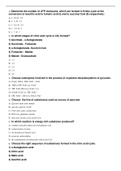
-
Biochemistry usmle step 1 2023 questions and answers
- Exam (elaborations) • 69 pages • 2023
- Available in package deal
-
- $19.49
- + learn more
1. Determine the number of ATP molecules, which are formed in Krebs cycle at the conversion of isocitric acid to fumaric acid (I) and to succinyl CoA (II) respectively: A) I -7,0; II - 5,5 B) I - 5; II - 3,5 C) I - 6,5; II - 4,5 D) I - 7,5; II - 5 E) I - 7; II - 3 2. In which stages of citric acid cycle is CO2 formed? 1) Izocitrate - α-Ketoglutarate 2) Succinate - Fumarate 3) α-Ketoglutarate -Succinil-CoA 4) Fumarate – Malate 5) Malate –Oxaloacetate A) 1,3 B) 2,4 C) 1,4 D) ...
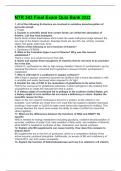
-
NTR 343 Final Exam Quiz Bank 2022
- Exam (elaborations) • 14 pages • 2024
-
- $13.49
- + learn more
NTR 343 Final Exam Quiz Bank 2022 1. All of the following B vitamins are involved in oxidative decarboxylation of pyruvate except: c. Folate 2. Explain in scientific detail how certain foods can inhibit the absorption of thiamin. List four food examples. Some foods contain thiaminases which break the weak methylene bridge between the two rings in the thiamin structure. Example foods are raw fish, tea, shrimp, mussels, clams, fish paste, betel nuts, ferns 3. Which of the following is not a...
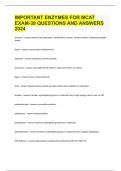
-
IMPORTANT ENZYMES FOR MCAT EXAM-39 QUESTIONS AND ANSWERS 2024.
- Exam (elaborations) • 4 pages • 2023
- Available in package deal
-
- $14.99
- + learn more
protease protein that hydrolyzes, and therefore cleaves, another protein; hydrolyzes peptide bonds. lipase enzyme that hydrolyzes fats. 6 Ways to Show Appreciation for Your Child's Teacher 0:00 / 0:54 hydrolase hydrolyzes chemical bonds. isomerase rearranges bonds within a molecule to form an isomer. ligase forms a chemical bond. lyase breaks chemical bonds by means other than oxidation or hydrolysis. kindase transfers a phosphate group to a ...
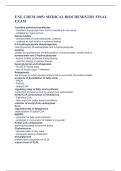
-
UNE CHEM 1005: MEDICAL BIOCHEMISTRY FINAL EXAM
- Exam (elaborations) • 2 pages • 2024
-
- $10.49
- + learn more
UNE CHEM 1005: MEDICAL BIOCHEMISTRY FINAL EXAM Carnitine palmitoyl transferase - transfers acyl groups from CoA to carnitine & vice versa - inhibited by malonyl-CoA ketone bodies - acetoacetate, β-hydroxybutyrate, acetone - oxidized as fuel source in extreme fasting d-3-hydroxybutyrate dehydrogenase interconversion of acetoacetate and 3-hydroxybutyrate acetone yielded by spontaneous decarboxylation of acetoacetate; waste product acetoacetate and 3-hydroxybutyrate - ketone bodies p...
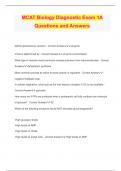
-
MCAT Biology Diagnostic Exam 1A Questions and Answers
- Exam (elaborations) • 48 pages • 2024
- Available in package deal
-
- $13.49
- + learn more
MCAT Biology Diagnostic Exam 1A Questions and Answers Define spontaneous reaction - Correct Answer️️ -exergonic Vmax is determined by - Correct Answer️️ -enzyme concentration What type of reaction most commonly creates polymers from macromolecules - Correct Answer️️ -dehydration synthesis Most common process by which enzyme activity is regulated - Correct Answer️️ - negative feedback loop In cellular respiration, what acts as the final electron acceptor if O2 is not avail...
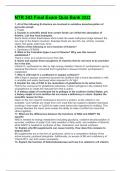
-
NTR 343 Final Exam Quiz Bank 2022
- Exam (elaborations) • 14 pages • 2024
-
- $10.98
- + learn more
NTR 343 Final Exam Quiz Bank 2022 1. All of the following B vitamins are involved in oxidative decarboxylation of pyruvate except: c. Folate 2. Explain in scientific detail how certain foods can inhibit the absorption of thiamin. List four food examples. Some foods contain thiaminases which break the weak methylene bridge between the two rings in the thiamin structure. Example foods are raw fish, tea, shrimp, mussels, clams, fish paste, betel nuts, ferns 3. Which of the following is not a...

-
biochemistry usmle step 1 questions and answers
- Exam (elaborations) • 69 pages • 2023
- Available in package deal
-
- $18.49
- + learn more
. Determine the number of ATP molecules, which are formed in Krebs cycle at the conversion of isocitric acid to fumaric acid (I) and to succinyl CoA (II) respectively: A) I -7,0; II - 5,5 B) I - 5; II - 3,5 C) I - 6,5; II - 4,5 D) I - 7,5; II - 5 E) I - 7; II - 3 2. In which stages of citric acid cycle is CO2 formed? 1) Izocitrate - α-Ketoglutarate 2) Succinate - Fumarate 3) α-Ketoglutarate -Succinil-CoA 4) Fumarate – Malate 5) Malate –Oxaloacetate A) 1,3 B) 2,4 C) 1,4 D) 3...
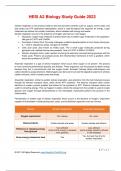
-
HESI A2 Biology Study Guide 2023
- Exam (elaborations) • 47 pages • 2023
-
- $10.99
- + learn more
HESI A2 Biology Study Guide 2023 Cellular respiration is the process inside of cells that converts nutrients (such as sugars, amino acids, and fatty acids) into ATP (adenosine triphosphate), which is used throughout the organism for energy. Large molecules are broken into smaller molecules, which releases both energy and waste. Aerobic respiration occurs in the presence of Oxygen and has four main stages: Glycolysis: Larger sugar molecule is broken down into 2 smaller sugar molecules in...
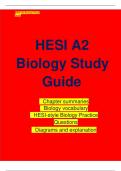
-
2023 HESI A2 Biology Study Guide
- Other • 45 pages • 2023
- Available in package deal
-
- $17.97
- + learn more
HESI A2 Biology Study Guide • Chapter summaries • Biology vocabulary • HESI-style Biology Practice Questions • Diagrams and explanation Cellular respiration Cellular respiration is the process inside of cells that converts nutrients (such as sugars, amino acids, and fatty acids) into ATP (adenosine triphosphate), which is used throughout the organism for energy. Large molecules are broken into smaller molecules, which releases both energy and waste. Aerobic respi...
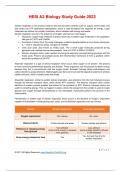
-
HESI A2 Biology Study Guide 2023
- Exam (elaborations) • 47 pages • 2023
- Available in package deal
-
- $12.99
- + learn more
HESI A2 Biology Study Guide 2023 Cellular respiration is the process inside of cells that converts nutrients (such as sugars, amino acids, and fatty acids) into ATP (adenosine triphosphate), which is used throughout the organism for energy. Large molecules are broken into smaller molecules, which releases both energy and waste. Aerobic respiration occurs in the presence of Oxygen and has four main stages: Glycolysis: Larger sugar molecule is broken down into 2 smaller sugar molecules in...

$6.50 for your textbook summary multiplied by 100 fellow students... Do the math: that's a lot of money! Don't be a thief of your own wallet and start uploading yours now. Discover all about earning on Stuvia


